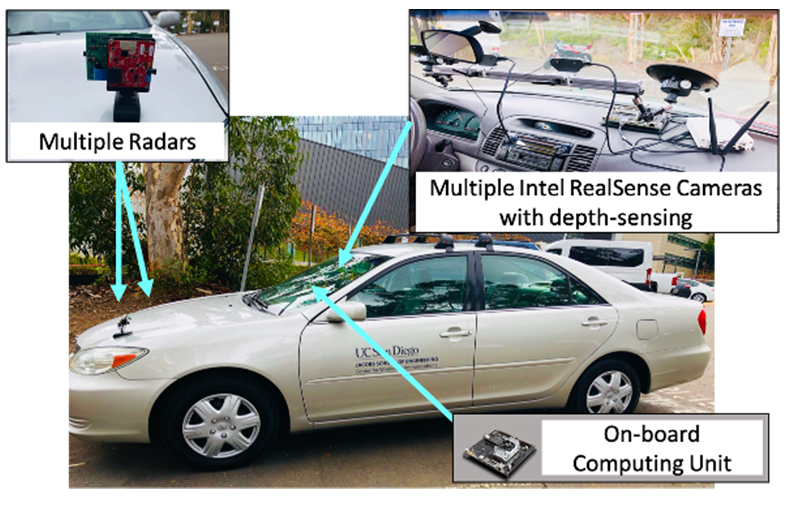Computing & Communications
Open configuration options Cellular Vehicle-to-Everything (C-V2X)
The current Cellular Vehicle-to-Everything (C-V2X) Sidelink communication protocol provides a low latency interface for sharing short safety messages among Road-Side Units (RSUs) and On-Board Units (OBUs). However, the protocol is primarily designed for broadcasting small messages and lacks link adaptation capabilities – this project utilizes AI/ML techniques to augment C-V2X Sidelinks with this adaptation capability in order to enable emerging applications such as vehicular sensor fusion.
C-V2X Testbed
The UCSD Center for Wireless Communications, in partnership with Qualcomm and Commsignia, deployed commercial C-V2X technologies on the UCSD campus in June 2021, extending our vehicular networking testbed with the latest commercially available vehicular radios. The testbed consists of a solar powered intelligent RSU deployed onto a lamp post along with multiple OBUs that can be installed into any vehicle in our fleet for drive test field experiments. The RSU consists of a Commsignia RSU module that utilizes a Qualcomm modem and antennas mounted high on the lamp post to communicate with vehicles using C-V2X Sidelinks. The intelligent RSU also hosts edge computing resources (Jetson TX2) to provide the enabling infrastructure for on-premise sensor fusion applications.
C-V2X QoS Characterization and Supervised Link Adaptation
The primary design constraint for C-V2X is that there is no feedback from the receiver on channel state that allows the sender to adapt their transmit configuration. As a result, there is essentially no ability to adapt transmission parameters to current link quality and instead these parameters are often updated in relation to vehicle speed, to combat doppler effects, or geographic location, to comply with local regulations according to a static configuration file. This project asks: how can we add this link adaptation capability to C-V2X without the need to change the underlying protocol to provide feedback? Researchers with the Center for Wireless communications conducted multiple drive tests on campus to characterize the C-V2X Sidelink performance (i.e. packet loss and latency) with respect to speed, location, Modulation & Coding Scheme, and Packet Sizes. The researchers then utilized supervised The RSU composition The OBU composition learning to build a predictive model of packet loss and latency in relation to the readily available context of vehicle location and speed along with the controllable link parameters of Modulation & Coding Scheme and Packet Size. Utilizing these predictive models to create a link adaptation policy for transmission of image frames over C-V2X Sidelinks resulted in a 28% improvement in the frames per second which could be achieved over the best static policy configuration that was tested. Moreover, this research has demonstrated that today’s vehicular networking technologies can be readily augmented with ability to share images from vehicles to the roadside edge which can enable advanced use cases such as collaborative perception, predictive maintenance, and intelligent traffic management.
.png)

